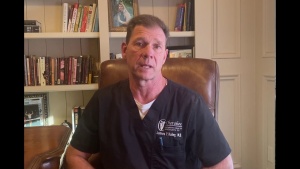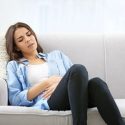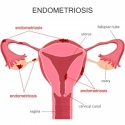Endometriosis
Endometriosis
Endometriosis is a condition where tissue from the lining of the uterus, called the endometrium, forms and grows in places outside the uterus. These growths may lead to pain and infertility. Up to 50% of women who have endometriosis may experience infertility.
If you had painful periods as a teenager, it is very likely you have endometriosis. This problem often goes undiagnosed because women “get used to” the pain.
Dr. Michael Litrel of Cherokee Women’s Health discusses endometriosis.
Symptoms of Endometriosis
- Pelvic pain
- Cramps
- Bloating
- Painful sex
- Fatigue
In endometriosis, displaced endometrial tissue continues to act as it normally would — it thickens, breaks down and bleeds with each menstrual cycle. Because this displaced tissue has no way to exit your body, it becomes trapped. When endometriosis involves the ovaries, cysts called endometriomas may form. Surrounding tissue can become irritated, eventually developing scar tissue and adhesions — abnormal tissue that binds organs together.
Endometriosis can cause pain — sometimes severe — especially during your period. Fertility problems also may develop. Fortunately, effective treatments are available.
Causes of Endometriosis
The exact cause of endometriosis is not known. However, possible causes include the following:
- Your immune system may not be getting rid of endometrial cells outside of the uterus like it should.
- Heavy bleeding or an abnormal structure of the uterus, cervix, or vagina causes too many endometrial cells to go up through the fallopian tubes and then into the belly. (This is called retrograde menstruation).
- Blood or lymph fluid may carry endometrial cells to other parts of the body. Or the cells may be moved during a surgery, such as an episiotomy or a cesarean delivery.
- Cells in the belly and pelvis may change into endometrial cells.
- Endometrial cells may have formed outside the uterus when you were a fetus.
It may be passed down through families.
When to Call Your Doctor
If you develop sudden, severe pelvic pain, call your doctor immediately. Call a doctor to schedule an appointment if:
- Your periods have changed from relatively pain-free to painful.
- Pain interferes with your daily activities.
- You begin to have pain during intercourse.
- You have painful urination, blood in your urine, or an inability to control the flow of urine.
- You have blood in your stool, you develop pain, or you have a significant, unexplained change in your bowel movements.
- You are not able to become pregnant after trying for 12 months.
- If you plan to become pregnant and have painful periods or painful sex
Treatment Options
There is no cure for endometriosis, but treatment can help with pain and infertility. Treatment depends on how severe your symptoms are and whether you want to get pregnant.
Hormone Therapy
If you have pain only, hormone therapy to lower your body’s estrogen levels will shrink the implants and may reduce pain. If you want to become pregnant, having surgery, infertility treatment, or both may help.
Medicines
If you have pain or bleeding but aren’t planning to get pregnant soon, birth control hormones (patch, pills, or ring) or anti-inflammatories (NSAIDs) may be all that you need to control pain. Birth control hormones are likely to keep endometriosis from getting worse. If you have severe symptoms or if birth control hormones and NSAIDs don’t work, you might try a stronger hormone therapy. Besides medicine, you can try other things at home to help with the pain. For example, you can apply heat to your belly, or you can exercise regularly.
Surgery
If hormone therapy doesn’t work or if growths are affecting other organs, surgery is the next step. It removes endometrial growths and scar tissue. This can usually be done through one or more small incisions, using laparoscopy. Laparoscopy can improve pain and your chance for pregnancy.
In severe cases, removing the uterus and ovaries (hysterectomy and oophorectomy) is an option. This surgery causes early menopause. It is only used when you have no pregnancy plans and have had little relief from other treatments.
In Conclusion
Not all women with endometriosis have pain. And endometriosis doesn’t always get worse over time. During pregnancy, it usually improves, as it does after menopause. If you have mild pain, have no plans for a future pregnancy, or are near menopause (around age 50), you may not feel a need for treatment. The decision is up to you.
As OB/GYNs, we specialize in protecting your fertility and providing treatment to relieve physical suffering. Our three board-certified specialists in Female Pelvic Medicine and Reconstructive Surgery (FPMRS) provide an exceptional level of expertise you won’t find in any other OB/GYN practice in the Southeast.
Please contact us today to schedule your appointment by calling 770.720.7733 or simply make an appointment online.
Endometriosis Education Articles

Could You Have Endometriosis?

Can I Get Pregnant if I Have Endometriosis?

Endometriosis – Shannon’s Story of a Hidden Disease

The Importance of Getting Established with an OB/GYN in Your Early 20s

No More Painful Periods

Relief After Endometrial Ablation

PCOS and Endometriosis – A Patient’s Story

Endometriosis – A Patient’s Story

Fertility Assistance

Endometriosis – Know the Facts



